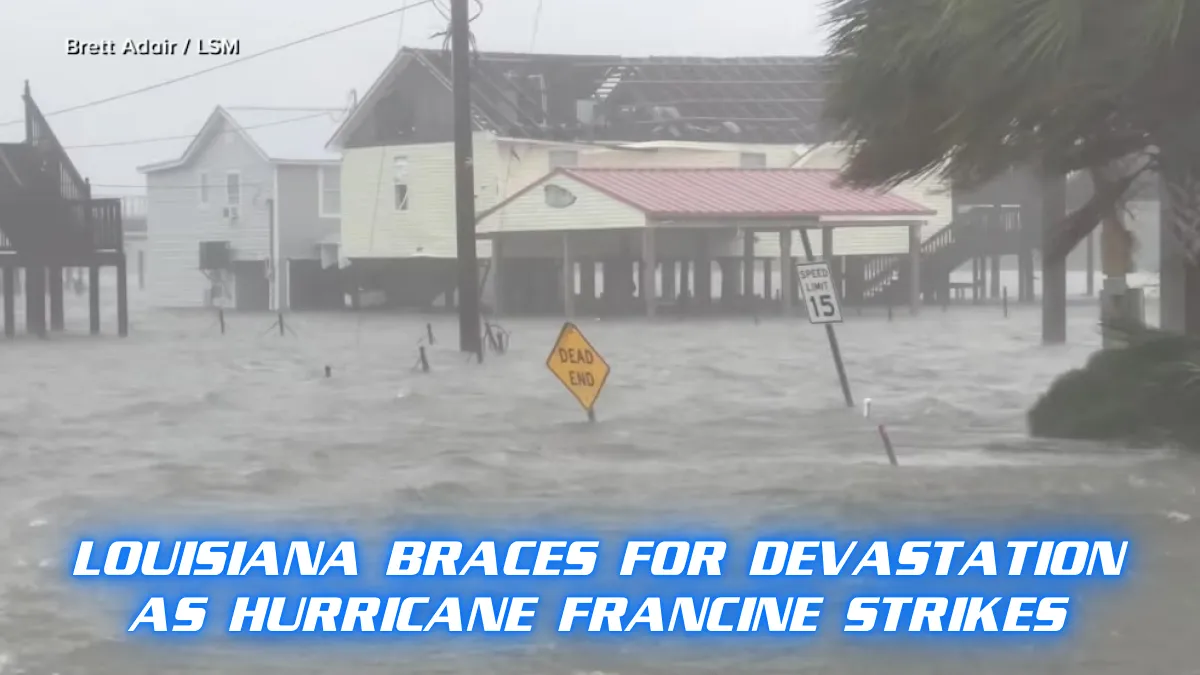On Thursday, September 12, 2024, Hurricane Francine made landfall in Louisiana, bringing with it catastrophic winds and heavy rain. The Category 4 hurricane, with wind speeds exceeding 140 miles per hour, hit the coast near New Orleans early in the morning, causing widespread destruction. Local authorities had issued evacuation orders days in advance, but some residents stayed behind, hoping to weather the storm. Now, the damage is far worse than anyone expected.
Residents in the hardest-hit areas are describing scenes of utter devastation. Trees have been torn from the ground, power lines are down, and many homes have been completely destroyed. Streets are flooded, and rescue operations are underway to help those stranded in their homes. In New Orleans, the city’s levee system, which was rebuilt after Hurricane Katrina in 2005, is being tested once again. So far, reports suggest the levees are holding, but experts fear that continued rainfall could overwhelm them.
In the coastal towns of Grand Isle and Port Fourchon, initial reports indicate significant damage to homes and businesses. Entire neighborhoods are submerged under several feet of water, and roads are completely impassable. Emergency responders are working around the clock to assess the damage and assist those in need. Many have been left without power, and utility companies have warned that it could take days or even weeks to restore electricity in some areas.
Local hospitals have been preparing for the worst, setting up emergency response teams to deal with potential injuries from the storm. Several shelters across the state are now at full capacity, with displaced families seeking refuge. Volunteers are arriving to provide food, blankets, and other essentials, but the scale of the disaster is overwhelming.
Meteorologists had been tracking Hurricane Francine for several days before it made landfall, warning residents of its potential to cause severe damage. The storm grew stronger as it moved across the Gulf of Mexico, fed by warm waters that intensified its winds. By the time it reached the Louisiana coast, it was one of the most powerful hurricanes to hit the state in recent memory. Experts are already comparing it to other historic storms like Hurricane Katrina and Hurricane Ida.
Governor John Bel Edwards has declared a state of emergency across Louisiana, activating the National Guard to assist in rescue efforts. In a statement, the governor urged residents to stay indoors and avoid unnecessary travel. “This is a dangerous and life-threatening situation,” he said. “Our top priority is the safety of the people of Louisiana. We are doing everything we can to help those affected by this devastating storm.”
The impact of Hurricane Francine is not limited to Louisiana. Neighboring states, including Mississippi and Alabama, are also bracing for severe weather as the storm moves inland. Heavy rain is expected to cause flash flooding in low-lying areas, and tornado warnings have been issued in several counties. Emergency services across the region are on high alert, ready to respond as the storm progresses.
Many in Louisiana are drawing comparisons between Francine and previous hurricanes that have struck the state. Hurricane Katrina, which hit nearly 20 years ago, left a lasting impact on the region, and residents are still haunted by the memories of that disaster. While the levee system in New Orleans has been strengthened since then, concerns remain about the city’s ability to withstand such a powerful storm. As of now, there have been no reports of major levee breaches, but officials are closely monitoring the situation.
In the days leading up to the storm, people across the state scrambled to prepare. Supermarkets were packed as residents stocked up on supplies, and hardware stores sold out of generators and plywood. Schools and businesses closed early, and traffic on major highways came to a standstill as families fled to safer areas. For many, this is an all-too-familiar scene.
As Hurricane Francine continues to move inland, the full extent of the damage is still unclear. Early estimates suggest that the cost of rebuilding could run into the billions of dollars. The Federal Emergency Management Agency (FEMA) is expected to provide financial assistance to those affected, but it will likely take months, if not years, for some communities to fully recover. In the meantime, residents are left to pick up the pieces and begin the long process of rebuilding their lives.
This is the third major hurricane to hit the Gulf Coast this year, raising concerns about the increasing frequency and intensity of storms in the region. Climate scientists have warned that rising global temperatures are contributing to the formation of more powerful hurricanes, and Louisiana’s coastal cities are among the most vulnerable in the country. For now, the focus remains on rescue and recovery, but the long-term implications of this storm will be felt for years to come.
The people of Louisiana are no strangers to hurricanes, but Hurricane Francine is proving to be one of the most destructive in recent memory. With entire communities under water and thousands of homes damaged or destroyed, the state faces an enormous challenge in the days ahead.

















